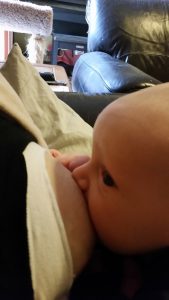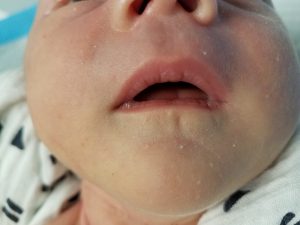
Latch is the most important part of the breastfeeding relationship. Yes, many have been able to Exclusively Pump, however that is rarely the first choice. Understanding how latch should work may help you troubleshoot your own breastfeeding issues or allow you to know when you need to bring in help. Many parts of a baby’s body play a large role in how successful breastfeeding is. I outline the function of each below.
Cheeks
Babies are born with nice chubby cheeks. While those cheeks make everyone want to snuggle right up to them they have a very important purpose. These are called Buccal fat pads and they keep the baby’s mouth from collapsing inward. Without these pads babies would have to use the same motion to drink from a straw. That would not only be ineffective, but would be painful for the parent to experience. Some premature babies that born at very low birth weight may not have adequate fat stores to fill this
Tongue
The tongue is a pretty important part of the breastfeeding process. This is what helps create the negative pressure needed to remove milk from the breast. The tongue has to make some pretty complex movements. It has to be extended beyond the lower gums and the mid-tongue needs to be able to move up towards the spot where the hard and soft palates meet without crushing the nipple or breaking the seal. Then the mid-tongue moves down to remove the milk from the breast. This has to happen rhythmically and comfortably for baby to remove the milk without causing fatigue. During this whole process baby has to make sure breathing is timed perfectly in a pattern known as “suck, swallow, breathe.”
Lips
The lips have a very important, but simpler task than the tongue. While the lips are important their job is more passive than the tongue. The lips need to be able to flare outward and use the wet inside of the lips to come out and create a seal to keep the baby from breaking suction or swallowing air. If a baby swallows air it can cause gas pains, fatigue, and a feeling of fullness that can interfere with reaching full belly status. It can also accompany nipple pain or trauma. If you hear clicking that’s the sign that seal is breaking. Pain and the appearance of sucking blisters (pictured below) indicate the lips are being used actively while nursing.

Hands
While the hands can be annoying they play an important role. After birth babies use their hands to locate the nipple for that first latch. They leave a trail of amniotic fluid to help their search (Don’t wash the hands for a few days). The hands can help trigger the milk to let down faster and also can be used to speed up the flow. Next to crying the hands are the next best communication device babies have. If the hands are batting at the nipple or otherwise getting in the way that says “hey, I’m uncomfortable over here!” That tells you the position you are using doesn’t feel quite right. If the hands stay clenched throughout a feeding that says “this is difficult. I need help.” Let those hands free and pay attention to the message they send you.
Neck
Lots of attention is paid to a baby’s neck after birth. Often I see parents very careful with supporting the baby’s head and neck, but the most common concern is overlooked. Many babies are born after prolonged labors, instrument assisted delivery, prolonged pushing phase, or malposition in utero to name a few. This can be relatively minor, but the discomfort caused may prevent a baby from tilting their head back or may make certain positions too uncomfortable in the early weeks. If your baby has an issue you may notice they prefer to turn their head to one side or their body may be curved when laying flat. Pay close attention to your baby’s cues. If you notice discomfort change positioning to relieve pressure from the area. This often resolves after a few weeks of tummy time (a few times a day for up to 5 minutes each time on a parent’s chest or a firm service). Call a lactation consultant if you have trouble finding a comfortable position.
I hope you find this information helpful and please reach out for help if you need help interpreting the cues.
